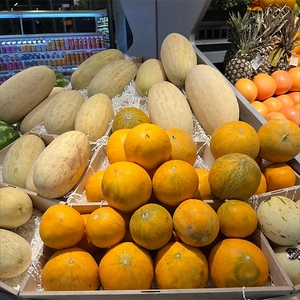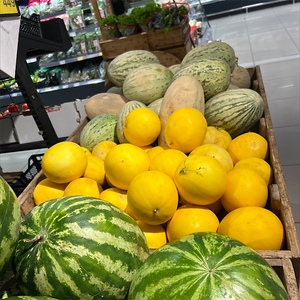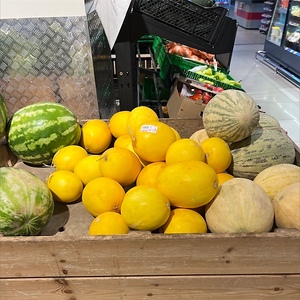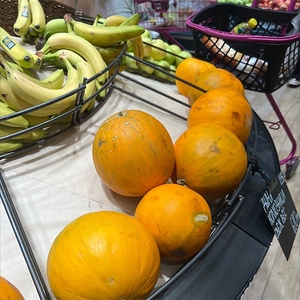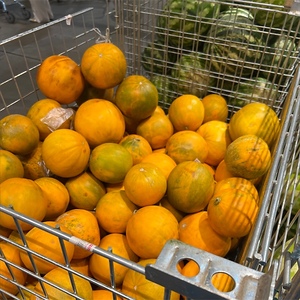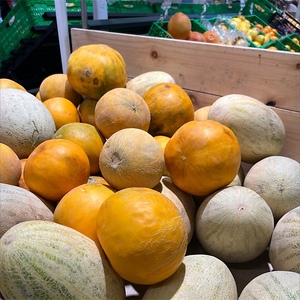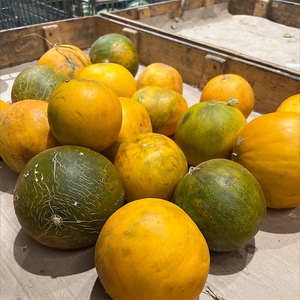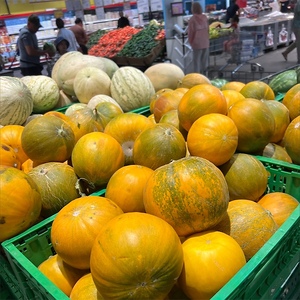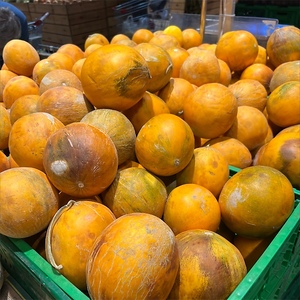


Kolkhoznitsa Melons
Estimated Inventory, lb : 0
Description/Taste
Kolkhoznitsa melons are a medium-sized varietal, averaging 15 to 20 centimeters in diameter, and have a round, ovate, to slightly oblong shape with a curved nature. The melons are typically harvested when they are 0.7 to 1.4 kilograms in weight, and the rind is moderately thick, firm, and elastic. The rind also showcases orange and golden yellow hues and occasionally bears hints of green, depending on the growing region. Kolkhoznitsa melons have a semi-smooth, textured rind covered in small grooves and mesh-like markings. Underneath the surface, the ivory to white flesh is dense, aqueous, succulent, and subtly crunchy. The flesh also encases a central cavity filled with tear-drop-shaped cream-colored seeds suspended in stringy fibers. Kolkhoznitsa melons emit a fragrant, honeyed aroma when ripe, and the melons should retain a dried portion of the stalk around 3 to 5 centimeters in length. Ripe Kolkhoznitsa melons will have a springy rind. If the rind remains dented when pressed, the melons are overripe. The flesh is known for its sugar content, ranging from 11 to 12 Brix, creating a sweet, sugary, and honeyed taste. The level of sweetness within the variety will vary depending on the region where the melon is cultivated. In cooler areas, the melon will be milder. In warmer regions, the flesh will develop a sweeter taste.
Seasons/Availability
Kolkhoznitsa melons are harvested in the late summer through mid-fall, spanning from August through October. Once picked, the melons are left for ten days in the sun and are vertically hung in storage facilities, where the variety will keep for sale until January.
Current Facts
Kolkhoznitsa melons, botanically classified as Cucumis melo, are a fragrant, sweet variety belonging to the Cucurbitaceae family. The mid-season variety was developed in the former Soviet Union in the 20th century and was selected for commercial and home garden production. Each Kolkhoznitsa melon plant typically expands up to three meters in length and can be grown in containers on trellises or in open fields sprawling across the ground. The variety can also be produced in greenhouses and is distinct for its fast-growing nature and short season. Kolkhoznitsa melons ripen in 77 to 95 days, and each plant produces up to three melons. Since their release, Kolkhoznitsa melons have become one of the most popular varieties cultivated in Russia. Growers favor the variety for its cold hardiness, drought resistance, and transportability, allowing it to be exported and sold outside its growing region. The seeds of the melon can also be saved, allowing growers to propagate new melons each season from their existing crop. In the modern day, Kolkhoznitsa melons are planted in home gardens and are a common commercial variety seen in supermarkets during the melon season. The melons are consumed fresh, cooked into preserves, or dried for extended use.
Nutritional Value
Kolkhoznitsa melons are a source of fiber to regulate the digestive tract, calcium to build strong bones and teeth, vitamin A to maintain healthy organs, and vitamin E to protect the cells against free radical damage. The melons also provide iron to develop the protein hemoglobin for oxygen transport through the bloodstream, magnesium to regulate nerve functioning, and other nutrients, including folate, vitamin B, and phosphorus. In Central Asia, Kolkhoznitsa melons are viewed as a refreshing snack and are consumed to cleanse the digestive tract.
Applications
Kolkhoznitsa melons have a sweet taste suited for fresh and cooked preparations. The variety is customarily eaten straight out of hand as a snack or healthy dessert. Kolkhoznitsa melons can also be added to fruit medleys, sliced and served on appetizer platters, or cut as a fresh topping over ice cream, breakfast dishes, and parfaits. In addition to raw dishes, Kolkhoznitsa melons are commonly simmered into jams, jellies, marmalades, and comfitures, or they are candied into a sweet treat. The melon's sweet taste can also be added as flavoring to fillings for desserts, puddings, and sorbets. Beyond culinary dishes, Kolkhoznitsa melons are blended or pureed into smoothies, juices, milkshakes, and cocktails. They are also dried into strips and consumed as a chewy snack. Dried melons can be chopped and added to granola, bars, and salads. Kolkhoznitsa melons pair well with herbs such as mint, parsley, and cilantro, citrus, vanilla, and maple syrup. Whole, unopened Kolkhoznitsa melons can be ripened at room temperature in a cool, dry, and dark place. Once ripe, the melons should be immediately consumed for the best quality and flavor.
Ethnic/Cultural Info
There are several theories behind the origins of the Kolkhoznitsa melon name. One theory points to the collective farms that were established in the Union of Soviet Socialist Republics or USSR. Kolkhoznitsa translates to mean the "collective farm woman" and is derived from Soviet Union residents who lived on state-owned land. These collective properties were centered around agriculture, and laborers who lived on the land were required to farm and tend to various agricultural duties. These collectives were voluntary residences, and melons were commonly grown in the gardens during the spring and summer. Around the same time that Kolkhoznitsa melons were released, collective farms were the only collective groups left in Russia. The second theory involves a woman who worked at the Biryuchekutskaya Experimental Station. One of the specialists who developed the melon was said to have inspired the name of the variety, but records or proof of this theory have been unsupported.
Geography/History
Kolkhoznitsa melons are native to Russia and were developed at the Biryuchekutskaya Experimental Station in the city of Novocherkassk in the Rostov Oblast region. The parent varieties of the melon are unknown, and the cultivar was created in the 1930s. In 1939, experimental station breeders applied to register the melon as a new variety, but it wasn't until 1943 that the melons were approved and registered. Kolkhoznitsa melons were developed as a variety that could be grown in cool, short seasons, and after their release, they became a widespread cultivar across Russia. Kolkhoznitsa melons were later introduced to Europe and were planted in open fields and greenhouses in countries such as Ukraine, France, the Netherlands, and Italy. The variety was also introduced to the United States in 1993. Today Kolkhoznitsa melon seeds are sold through online retailers and are grown in the region of Eastern Siberia, the North Caucasus, Astrakhan, Western Siberia, and the Far East in Russia. The melons are also produced on a smaller scale in Japan, Central Asia, Europe, and the United States.



